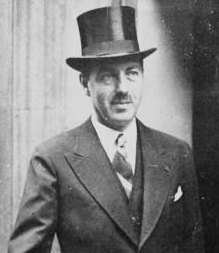Paul van Zeeland facts for kids
Quick facts for kids
Paul van Zeeland
|
|
|---|---|
 |
|
| Prime Minister of Belgium | |
| In office 25 March 1935 – 23 November 1937 |
|
| Monarch | Leopold III |
| Preceded by | Georges Theunis |
| Succeeded by | Paul-Emile Janson |
| Personal details | |
| Born |
Paul Guillaume van Zeeland
11 November 1893 Soignies, Belgium |
| Died | 22 September 1973 (aged 79) City of Brussels, Belgium |
| Political party | Catholic Party |
Paul Guillaume, Viscount van Zeeland (born November 11, 1893 – died September 22, 1973) was an important Belgian leader. He was a lawyer, an economist, and a politician. He was born in Soignies, Belgium.
Before becoming a top politician, Van Zeeland was a professor. He taught law and directed the Institute of Economic Science at the Catholic University of Leuven. He also worked at the National Bank of Belgium.
Contents
Paul van Zeeland: Prime Minister of Belgium
In March 1935, Paul van Zeeland became the Prime Minister of Belgium. He led a special government called a "national unity" government. This meant it included the three biggest political parties in Belgium: the Catholics, the Liberals, and the Socialists.
Tackling the Economic Crisis
When Van Zeeland became Prime Minister, Belgium was facing a tough economic crisis. To help the country, he was given special powers. He made the Belgian currency less valuable. This helped Belgian products become cheaper for other countries to buy. He also spent more government money to help the economy grow. These actions helped to make the economic situation better.
Dealing with Political Challenges
In 1936, Van Zeeland's government faced challenges from a group called Rexism. This was a Belgian fascist party. Because of their actions, his government resigned in the spring of 1936.
The 1936 Election and New Government
On May 24, 1936, a new general election took place in Belgium. The Labour party won 70 seats, Van Zeeland's Catholic Party won 61 seats, and the Rexists won 21 seats. Even with these changes, Paul van Zeeland continued as Prime Minister. He again led a national unity government with the three main parties.
The 1936 General Strike
In June 1936, a large strike started among dockworkers in the Port of Antwerp. It quickly spread to other factories and industries. Workers began to occupy their workplaces, meaning they stayed inside the factories to protest. This strike was unusual because both socialist and Catholic trade unions supported it.
Resolving the Strike
To solve the strike, Prime Minister Van Zeeland called a "National Labour Conference." This meeting brought together leaders from trade unions and companies. They reached an agreement that helped workers. This agreement included:
- A legal minimum wage, which is the lowest amount a worker can be paid.
- Six days of paid holidays each year.
- A maximum 40-hour working week for some industrial jobs.
The strike officially ended on July 2, 1936.
Belgium's Policy of Independence
Paul van Zeeland was Prime Minister until November 23, 1937. During his second term, his government took strong action against the Rexists. They also introduced measures to reduce unemployment, which helped calm political tensions.
Another important change during his time was Belgium's foreign policy. Belgium decided to end its military alliance with France. Instead, it returned to its traditional "neutrality" policy. This meant Belgium would not take sides in conflicts between other countries. This new approach was called a "policy of independence."
Later Career and Contributions
After his time as Prime Minister, Paul van Zeeland continued to serve Belgium and Europe.
- In 1939, he became the president of the Committee on Refugees in London.
- In 1944, he was made High Commissioner for helping Belgians who had been displaced during the war return home.
- In 1942, he was elected to the American Philosophical Society, a famous group of thinkers.
- In 1946, he helped start the European League for Economic Cooperation. This group worked to improve economic ties in Europe.
After World War II, he served as the Minister of Foreign Affairs for Belgium from 1949 to 1954. He also advised the Belgian government and the North Atlantic Treaty Organisation on economic matters. He was an honorary leader of the Steering Committee of the Bilderberg meeting.
See also
 In Spanish: Paul van Zeeland para niños
In Spanish: Paul van Zeeland para niños
- Belgian general strike of 1936

